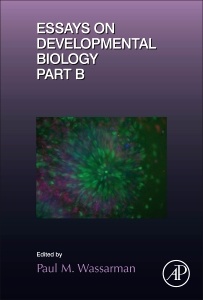Essays on Developmental Biology Part B Current Topics in Developmental Biology Series
Langue : Anglais
Auteur : Wassarman Paul

In 2016 Current Topics in Developmental Biology (CTDB) will celebrate its 50th or ?golden anniversary. To commemorate the founding of CTDB by Aron Moscona (1921-2009) and Alberto Monroy (1913-1986) in 1966, a two-volume set of CTDB (volumes 116 and 117), entitled Essays on Development, will be published by Academic Press/Elsevier in early 2016. The volumes are edited by Paul M. Wassarman, series editor of CTDB, and include contributions from dozens of outstanding developmental biologists from around the world. Overall, the essays provide critical reviews and discussion of developmental processes for a variety of model organisms. Many essays relate the history of a particular area of research, others personal experiences in research, and some are quite philosophical. Essays on Development provides a window onto the rich landscape of contemporary research in developmental biology and should be useful to both students and investigators for years to come.
Part of two 50th Anniversary volumes including contributions from dozens of outstanding developmental biologists from around the world1. Epigenetic Regulation by ATP-Dependent Chromatin Remodeling Enzymes: SNF-ing out CrosstalkJohn S. Runge, Jesse R. Raab and Terry Magnuson2. The Emergence of Three-Dimensional Patterns During MorphogenesisDavid R. McClay3. Development of the Mammalian KidneyAndrew P. McMahon4. Applied Developmental Biology: Making Human Pancreatic Beta cells for DiabeticsD.A. Melton5. The Dishevelled Protein Family: Still Rather a Mystery After Over 20 Years of Molecular StudiesMarek Mlodzik6. When Family History Matters: the Importance of Lineage Analyses and Fate Maps for Explaining animal DevelopmentSteven L. Klein and Sally A. Moody7. Frizzled Receptors in Development and DiseaseYanshu Wang, Hao Chang, Amir Rattner and Jeremy Nathans8. The Developmental Genetics of Vertebrate Colour Pattern Formation: Lessons from ZebrafishUwe Irion, Ajeet Pratap Singh and Christiane Nüsslein-Volhard9. Defining “DevelopmentThomas Pradeu, Lucie Laplane, Karine Prévot, Thierry Hoquet, Valentine Reynaud, Giuseppe Fusco, Alessandro Minelli, Virginie Orgogozo and Michel Vervoort10. Concepts of Cell Lineage in Mammalian EmbryosVirginia E. Papaioannou11. Small Peptides as Newcomers in the Control of Drosophila DevelopmentJ. Zanet, H. Chanut-Delalande, S. Plaza and F. Payre12. Towards a Systems Understanding of Signaling Pathway FunctionDavid P. Doupé and Norbert Perrimon13. Implications of Developmental Gene Regulatory Networks Inside and Outside Developmental BiologyIsabelle S. Peter and Eric H. Davidson14. Evo-Devo: Discovery of Diverse Mechanisms Regulating DevelopmentAlys M. Cheatle Jarvela and Leslie Pick15. Making the Mouse Blastocyst: Past, Present and FutureJanet Rossant16. Two Decades of Ascidian Developmental Biology: A Personal Research StoryNoriyuki Satoh17. Lineage Segregation in the Totipotent EmbryoGuangming Wu and Hans R. Schöler18. The Complexities and Unexpected Insights of Developmental Genetic AnalysisTrudi Schupbach19. Homeodomains, Hedgehogs, and HappinessMatthew P. Scott20. Turning One Cell Type into AnotherJonathan M.W.Slack21. Mechanotransduction During Vertebrate NeurulationSergei Y. Sokol22. Preformation Versus Epigenesis in Early Mammalian DevelopmentDavor Solter23. A Thousand and One Receptor Tyrosine Kinases: Wherein the Specificity?Harish N. Vasudevan and Philippe Soriano24. The Carnegie Department of Embryology at 100: Looking ForwardAllan C. Spradling25. Organ Function as a Modulator of Organ Formation: Lessons from ZebrafishMichelle M. Collins and Didier Y.R. Stainier26. Organizers in DevelopmentClaire Anderson and Claudio D Stern27. The Soft Touch: Low Affinity Transcription Factor Binding Sites in Development and EvolutionJustin Crocker, Ella Preger-Ben Noon and David L. Stern28. Developmental Competence for the Primordial Germ Cell FateUfuk Günesdogan and M. Azim Surani29. Formation of the Embryonic Head in the Mouse: Attributes of a Gene Regulatory Network Patrick P. L. Tam, Nicolas Fossat, Emilie Wilkie, David A. F. Loebel, Chi Kin Ip and Mirana Ramialison30. Developmental Biology - We are all Walking MutantsPaul A Trainor31. A Bespoke Coat for Eggs: Getting Ready for Fertilization Paul M. Wassarman and Eveline S. Litscher32. Germ Line Mechanics – and Unfinished BusinessGary M. Wessel33. Positional Information and Cell Fate Determination in the Early Drosophila EmbryoEric Wieschaus34. Segment Identity and Cell Segregation in the Vertebrate Hindbrain Megan Addison and David G. Wilkinson35. Positional Information and Pattern FormationLewis Wolpert36. The Birth of Animal Development: Multicellularity and the GermlineHugh R. Woodland37. Pli selon Pli: Mechanochemical Feedback and the Morphogenetic Role of Contractility at Cadherin Cell-Cell Junctions Bipul R. Acharya and Alpha S. Yap38. From Endoderm to Liver Bud: Paradigms of Cell Type Specification and Tissue MorphogenesisKenneth S. Zaret39. The Acquisition of Cell Fate in Mouse Development: How do Cells First Become Heterogeneous?Sarah J L Graham and Magdalena Zernicka-Goetz
Paul M. Wassarman, the Series Editor of CTDB since 2007, is Professor in the Dept. Developmental and Regenerative Biology at the Icahn School of Medicine at Mount Sinai in New York City. He received a Ph.D. in biochemistry from Brandeis University where he carried out thesis research in the Graduate Dept. Biochemistry with Professor Nathan O. Kaplan. In 1967 Wassarman joined the Division of Structural Studies at the MRC, Laboratory of Molecular Biology in Cambridge, England as a Helen Hay Whitney Foundation Fellow with Sir John C. Kendrew. In 1972 he joined the faculty of the Dept. Biological Chemistry at Harvard Medical School and in 1986 moved to the Roche Institute of Molecular Biology where he was Chair of the Dept. Cell and Developmental Biology and Adjunct Professor in the Dept. Cell Biology, New York University School of Medicine. In 1996 he moved to the Icahn School of Medicine at Mount Sinai where he was the Lillian and Henry M. Stratton Professorial Chair of the Dept. Molecular, Cell, and Developmental Biology. Wassarman has published more than 200 research papers and reviews, dealing primarily with mammalian oogenesis, fertilization, and early embryogenesis.
- Covers the area of developmental processes for a variety of model organisms
- International board of authors
- Part of two 50th Anniversary volumes proving a comprehensive set of reviews edited by Serial Editor Paul M. Wassarman
Date de parution : 03-2016
Ouvrage de 734 p.
15x22.8 cm
Thème d’Essays on Developmental Biology Part B :
Mots-clés :
Developmental Biology; model organism; genetics; molecular biology; cell biology
© 2024 LAVOISIER S.A.S.



